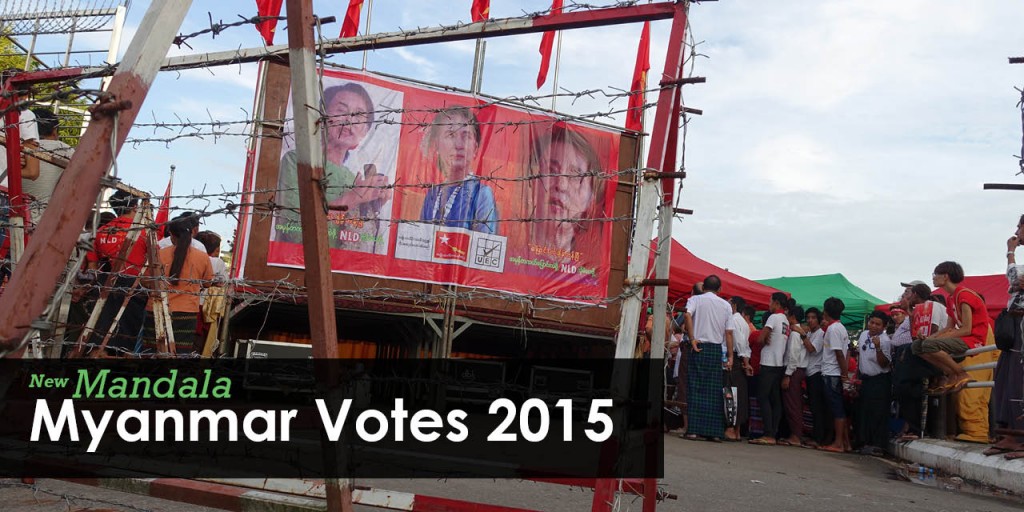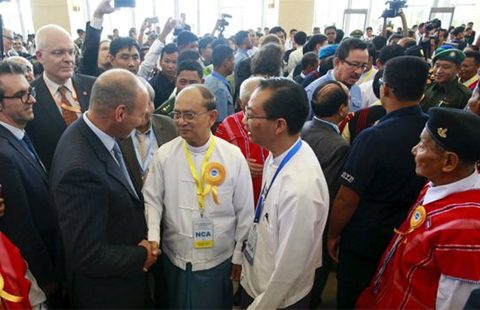
Is Myanmar finally on the path to peace, and will Sunday’s election spell an end to decades of conflict?
After nearly four years of protracted negotiations, the Myanmar Government and eight ethnic organisations signed the final version of a Nationwide Ceasefire Agreement (NCA) on 15 October, bringing hopes for peace to one of the world’s most ethnically diverse regions.
Hailed as one of President Thein Sein’s key political outcomes during the transition period to democracy, never before has Myanmar had a single, nationwide peace agreement containing uniform undertakings of any kind, although the former military regime had signed separate ceasefires with some individual ethnic groups during the 1990s.
The NCA was an extraordinary effort – all parties invested a great deal of political capital, physical and intellectual resources. Never before in the country’s history had so much time and preparation been directed at a single, structured negotiating process, where details and practical consequences were spelled out at every step.
The post-2011 political transition was increasingly being seen as without value if fighting with ethnic communities continued and peace negotiations were not a priority outcome of the reconciliation process, and the NCA agreement was achieved with the benefit of conflict resolution lessons learned from Norway’s successful participation in the Sri Lanka ceasefire initiative in 2002.
For the first time since independence in 1948, Myanmar’s leaders openly welcomed outside involvement in their own political problems. As many as 18 ethnic groups participated in the NCA discussions, which were also supported politically by the opposition National League for Democracy (NLD); while NLD head Aung San Suu Kyi did not attend, a senior NLD representative was one of the official “witnesses”. Australia was one of many international supporters of the process, contributing A$14 million and several peace-making experts since 2011.
Potentially, the NCA has both long-term and short-term effects, although these are not always treated discretely in ethnic expectations. Obviously, the main long-term objective is to lock in cooperative political arrangements to transform ceasefires into permanent peace settlements allowing for social, cultural and economic development fully reflecting Myanmar’s ethnic diversity. This did not happen after the original ceasefires of the 1990s, a reason why some of them did not survive. Yet many did, because all-important ongoing political agreements, although struck informally, were sometimes adhered to.
A permanent political arrangement beyond 2015 would include the much sought after political dialogue as a consultative mechanism to deal with any serious issues affecting the peace process.
The NCA’s equally important short-term effects include ending hostilities, and implementing any associated disarmament measures; return of displaced populations to their homes, and provision of any ongoing relief and resettlement assistance (including any necessary access for humanitarian organisations); and the re-commencement of ongoing productive lifestyles, again with any capacity-building support needed.
These demands of the various ethnic groups are totally understandable and the only reasonable basis for them to give up their armed struggle. Without some effective framework for nationwide progress such as the NCA (or any successor), lingering inequalities and gaps in Myanmar will be hard to overcome.
Criticisms of the NCA process have naturally focused on whether it is sufficiently inclusive, and therefore effective, without participation by all ethnic groups.
The main group omitted, on the Myanmar Government’s peculiar reasoning that it would not sign with parties engaged in ongoing hostilities against the government, is the Kachin Independence Army (KIA) whose earlier ceasefire broke down in 2011 and whose insurgency against the Burmese Army continues.
Talks have been held intermittently between the KIA and the government, but have so far not achieved results. Other groups not invited to participate include the Kokang (Chinese) Myanmar National Defence Army, the Ta’ang National Liberation Army, and the Arakan Army, the latter two numerically small local groups aligned with the much more significant Kachin Independence Army.
While the NCA’s accomplishments may be general, they are not trivial. To include the various Karen groups – who have been fighting with the central government and with each other for more than 60 years – is a significant landmark, as the Karen National Union leadership has itself publicly acknowledged.
To have so many key Myanmar parties operating under a single agreement, and ongoing international support arrangements is a reason to celebrate, and be hopeful. The NCA won’t instantly end the fighting, the overall peace process has not been concluded, but for many ethnic groups it will finally offer the groundwork towards a more comprehensive reconciliation.
Myanmar’s leaders face significant challenges – major outstanding ethnic conflicts among them, especially the devastating Kachin insurgency. Some of the other smaller armed ethnic groups have already taken part in some of the talks, and they need to be brought formally into the present arrangement.
In addition, other armed ethnic groups, such as the KIA and the United Wa State Army, need to be brought into the main peace-making process as soon as practicable. It may require considerable external support and assistance to achieve this, just as the NCA negotiations have been achieved so far. A substantive ongoing international presence in support of the long-term peace goals is easy to envisage.
Eventually, the fate of each of the armed ethnic groups may need to be resolved separately, according to individual circumstances. The tricky question of their political and organic relationship with the central Burmese army, the Tatamadaw, must also be settled as part of this process. As yet, there are no indicators as to how – or when – such questions might be resolved.
Trevor Wilson is a retired Australian diplomat who served as Australian Ambassador to Myanmar from 2000-03, and is a visiting fellow in the ANU Coral Bell School of Asia Pacific Affairs.
This article is published as a collaboration between New Mandala and Policy Forum, Asia and the Pacific’s platform for analysis and discussion on public policy. It forms part of New Mandala’s ‘Myanmar and the vote‘ series.
 Facebook
Facebook  Twitter
Twitter  Soundcloud
Soundcloud  Youtube
Youtube  Rss
Rss 